The Google Nexus 7 Review
by Anand Lal Shimpi & Brian Klug on July 26, 2012 11:35 AM ESTThe Display
In this new age of high resolution panels with small dimensions, the goal seems to be to just get the display out of the way. You shouldn't notice the display, it should just quietly do its job and make you believe that what you're looking at is real. When viewed with this critical eye, very few displays do their job well.
The Nexus 7's display is somewhere between good and perfection. It's not on the latter end of the spectrum, but it's great for $199. Black levels are good, and max brightness is more than enough for indoor use, although you'll have problems outdoors if it's too sunny.
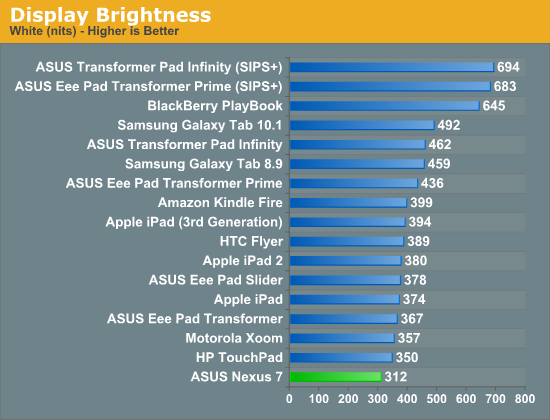
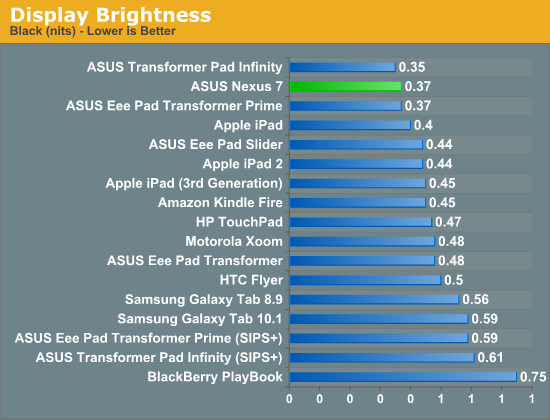

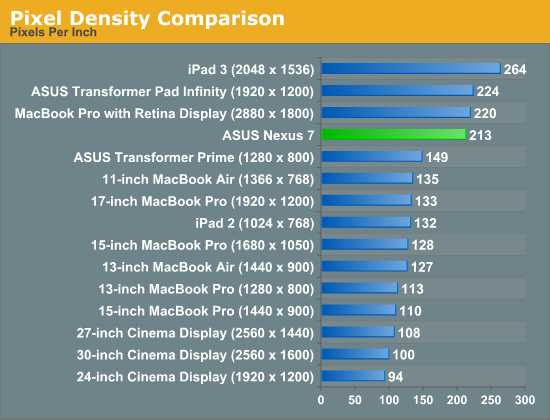
The resolution is high enough that neither Brian nor I were able to identify individual pixels at our normal viewing distances. Images do look better on the new iPad however (not a resolution but rather a panel advantage).
The other interesting aspect of the Nexus 7 is that it is a relatively new and somewhat interesting display form factor. 213 pixels per inch in a 7 inch display is unique for an Android tablet, and puts the Nexus 7 in the "tvdpi" screen density category for Android, 600 x 961 dp (that's dp - density independent pixels, relative to 160 ppi).
The end result is that some applications get a scaled down version of the 10" form factor Android 4.x UI, others don't. Some pages use the phone layout (for example the settings page, play store, and the notifications shade), others use the tablet two pane layout (for example Gmail) due to the 600dp width of the Nexus 7. That is to say it isn't totally correct to say that the UI on the Nexus 7 is a larger, scaled version of the phone UI, but something of an intermediary between the traditional 10" tablet version, and the phone version depending on what the break point is (in dps) for the particular app.
The other interesting note is that because 'tvdpi' isn't a primary display density for Android developers to build assets against, most often bitmaps get scaled down from the hdpi asset. In most places there isn't much of a noticeable softening of the edges, but I'll admit there are a few places where it's obvious bitmaps have been decimated and look a bit soft. Luckily, the pixel density of the display itself is high enough to mask most of this, but it isn't always perfect.
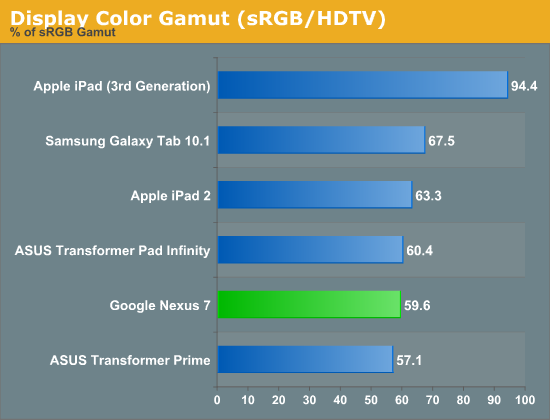
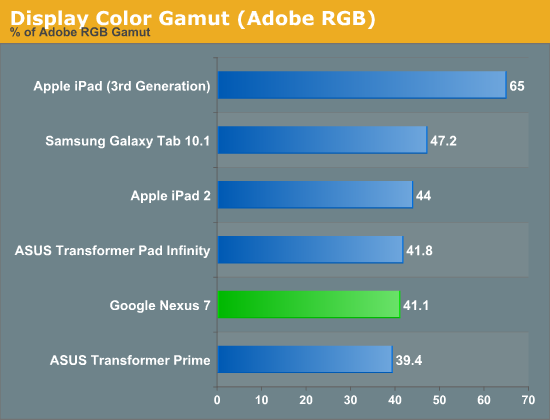
The Nexus 7's IPS panel offers great viewing angles, something that's simply a requirement for any device whose primary interface revolves around the display. Color accuracy is simply middle of the road, but I don't expect many users to do a lot of professional photo editing on the Nexus 7 so I'm not sure how much this actually matters.


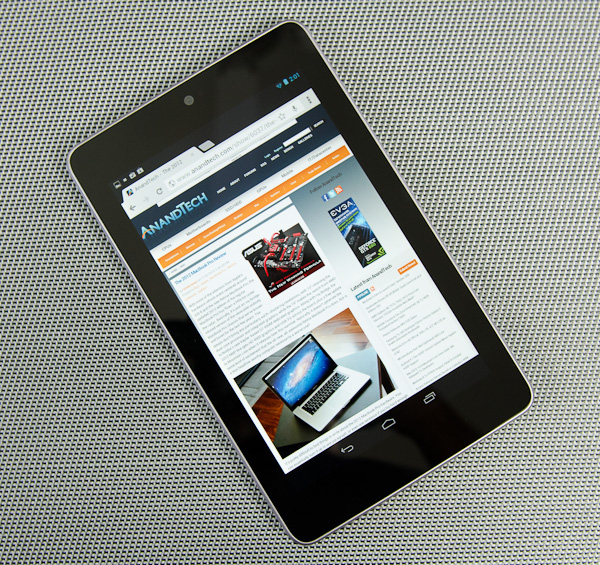








118 Comments
View All Comments
Sprchkn - Thursday, July 26, 2012 - link
Except that Flash isn't supported on Jelly Bean... I know, mine arrived yesterday and I tried that. Amazon either needs to release an Android app or move to HTML5.But, I've already cancelled the auto-renewal on my Prime account due to their use of Flash DRM which requires a workaround to install the deprecated HAL package under Gentoo so it's not like I'm married to them. Google actually seems to be the only one that supports both Linux and Android, so I'll just start purchasing my video content from them.
Impulses - Friday, July 27, 2012 - link
Flash works fine on Jelly Bean under Firefox and other browsers, just need to side load it.RamarC - Thursday, July 26, 2012 - link
will allow usb tthumb drive/sd cards to be used with the Nexus 7.WolvenSpectre - Thursday, November 8, 2012 - link
The problem is that it doesn't give you any write capability.Pino - Thursday, July 26, 2012 - link
"213 pixels per inch in a 7 inch display is unique for an Android tablet"Lenovo´s S2007 tablet has such a display and was launched way before the Nexus 7:
http://appserver.lenovo.com.cn/Lenovo_lepadSeries_...
eaanders@cox.net - Thursday, July 26, 2012 - link
The primary advantage of the Nexus 7 is price. If a tablet is so small you need to zoom, the sweet spot is the Galaxy Note. It's half the weight of the 7, fits in your shirt pocket, and combines the features of a phone, a camera, and a small tablet in one unit with the possibility of adding an additional 32 Gb of storage. The Note 2 will be even faster.My netbook will be replaced by a Windows 8 hybrid eventually for full computing power. This and the Galaxy Note are all I will need to do everything mobile.
Sprchkn - Thursday, July 26, 2012 - link
I think it depends on what you're using it for. I bought the Nexus 7 so that I can leave my phone docked up to my stereo and then look up recipes, check email, etc. while I'm in the kitchen cooking. The speakers are a bit weak, but it will probably also see some duty playing movies, again, while I'm cooking or perhaps when I'm on my treadmill. The missing storage hasn't been a problem for me with the way I use my phone and I always have my iPod available for music duty. Besides, for whatever reason, I've always had trouble with the micro SDs and corruption when copying large amounts of data onto them - so I'm actually relieved that Google Play means I no longer have to deal with that.MadMan007 - Thursday, July 26, 2012 - link
An unlocked Galaxy Note is over twice as expensive as the Nexus 7. It's only fair to compare unsubsidized vs unsubsidized pricing. Everyone's needs and wants are different, but the 'if you're going to zoom anyway' point is valid if one were going to get a subsidized phone anyway and can deal with the size of the Note as a phone.hackbod - Thursday, July 26, 2012 - link
Great stuff on the NAND performance, as well as the commentary on the screen configuration. Your reviews are consistently the most detailed and technically accurate I see.One thing that would be interesting to do is NAND performance comparisons with the 16GB model. I believe this uses a different NAND controller, so you should see some different interesting behavior. And since the 16GB model is likely more popular than the 8GB one, this would be relevant to many people.
risa2000 - Friday, July 27, 2012 - link
I would like to see similar tests (flash throughput) done also with smartphones. There has been rumors that there are some significant difference between some (e.g. iPhone and some Androids) and it would be interesting to know also for new WP devices.